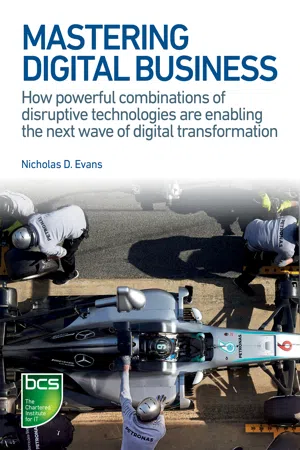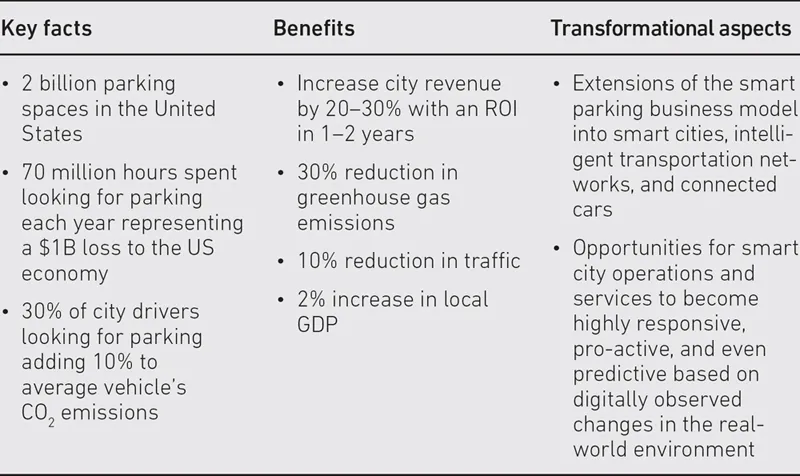
eBook - ePub
Mastering Digital Business
How powerful combinations of disruptive technologies are enabling the next wave of digital transformation
This is a test
- 196 pages
- English
- ePUB (mobile friendly)
- Available on iOS & Android
eBook - ePub
Mastering Digital Business
How powerful combinations of disruptive technologies are enabling the next wave of digital transformation
Book details
Book preview
Table of contents
Citations
About This Book
This strategic guide for business and IT executives focuses on how today's most disruptive technologies (including social, mobile, analytics, cloud, wearables, intelligent automation, robotics, and the IoT) can be applied in powerful combinations, together with platform business models, mastery of digital services, and leading practices in corporate innovation, to help you develop and execute your digital strategies for competitive advantage.
Frequently asked questions
At the moment all of our mobile-responsive ePub books are available to download via the app. Most of our PDFs are also available to download and we're working on making the final remaining ones downloadable now. Learn more here.
Both plans give you full access to the library and all of Perlego’s features. The only differences are the price and subscription period: With the annual plan you’ll save around 30% compared to 12 months on the monthly plan.
We are an online textbook subscription service, where you can get access to an entire online library for less than the price of a single book per month. With over 1 million books across 1000+ topics, we’ve got you covered! Learn more here.
Look out for the read-aloud symbol on your next book to see if you can listen to it. The read-aloud tool reads text aloud for you, highlighting the text as it is being read. You can pause it, speed it up and slow it down. Learn more here.
Yes, you can access Mastering Digital Business by Nicholas D. Evans in PDF and/or ePUB format, as well as other popular books in Business & Business General. We have over one million books available in our catalogue for you to explore.
Information
PART I
INSIGHT – SETTING YOUR DIGITAL TRANSFORMATION VISION
INSIGHT – SETTING YOUR DIGITAL TRANSFORMATION VISION
1 DESIGNING YOUR DIGITAL BUSINESS STRATEGY AND VISION
Software is eating the world.
Marc Andreessen1
In this chapter, we’ll explore the art of the possible with regard to digital business, why it’s so disruptive to traditional business models, and how to prepare for disruption in your industry. We’ll also look at some industry examples, such as smart parking, where new digitally based business models can not only disrupt their target markets but can be quickly expanded into market adjacencies.
In terms of the art of the possible, due to the ‘digital medium’ these new business models are designed to operate in, they have the intrinsic potential to be more transformative than they would appear from the outside. By digitising a traditionally analogue business model or process, we’re effectively turning it into bits and atoms and enabling an infinite variety of possibilities.
In terms of exploring why digital business is so disruptive to traditional business models and traditional notions of industry competition, we’ll analyse the situation by looking at Porter’s model of the five forces of industry competition and exploring how digital business is impacting each of the various forces.
Finally, in terms of how to prepare for digital disruption, we’ll explore some of the signs to watch out for and how to prepare your response. By its very nature, a disruption is extremely hard to predict. Still, with careful analysis of industry trends, a keen grasp of the art of the possible and observations of recent ‘seismic activity’, you can get a sense of what to prepare for and how to react.
THE ART OF THE POSSIBLE: THE HIDDEN DISRUPTION OF DIGITAL BUSINESS MODELS
Digital transformation is being applied by CEOs worldwide to re-think and re-design their traditional, existing business models and processes in the context of today’s disruptive technologies, the consumerisation of IT, ubiquitous low-cost computing and our globally connected society. It’s my belief that many of these new, social-, mobile-, analytics- and cloud-enabled (that is, SMAC-enabled) digital business models have the intrinsic potential to be more transformative than they would first appear from the outside.
One of the interesting questions often raised in regard to digital transformation initiatives is actually how ‘transformational’ the initiative really is.
Does the initiative truly create transformational change to the business model, process, product or service, or is it more of an incremental value-add?
First, this is a great question to ask of all of your digital initiatives. In essence, it is a litmus test to uncover the degree of change that’s anticipated, or already experienced, from deployment of your digital initiative. As the sponsor behind the initiative, or perhaps one of several stakeholders, you’ll know right away from your digital strategy the degree of change you’re aiming for. As you look across your portfolio of projects, it’s likely that some will be closer to the ‘transformational’ bar and others will be deliberately more ‘incremental’, but still intended to yield specific forms of measurable business value.
This ‘degree of transformation’ discussion is very much akin to the kinds of discussions I have with customers when conducting innovation workshops. In our particular form of these workshops, we encourage innovative ideas of all kinds: from strategic, and highly disruptive, ‘change the business’ types of ideas all the way to more tactical, incremental ideas. The idea with these particular workshops is that all ideas, from strategic to tactical, have initial merit and should be captured. As long as they’re aligned with the key focus areas of the workshop, determined ahead of time with the workshop sponsors, and are intended to add business value, then let’s go ahead and capture them for subsequent discussion and prioritisation.
As a sponsor or stakeholder you likely know the degree of transformation inherent in your initiative based upon your strategy, but what about the outside industry observer, customer or partner? As highlighted earlier, it’s my belief that due to the ‘digital medium’ these new business models are designed to operate in, they have the intrinsic potential to be more transformative than they would appear from the outside.
As discussed, by digitising a traditionally analogue business model or process, we’re effectively turning it into bits and atoms and enabling an infinite variety of possibilities. The rules can be whatever you want them to be – with the market being the petri dish to determine if the new rules are viable and can lead to adoption and growth.

CASE STUDY – STREETLINE
A smart parking example
A good example of the hidden disruption of digital business models – in terms of the hidden degree of transformational change – is smart parking. At first glance, it’s just a way to find a parking spot. Wireless sensors are embedded in parking spaces to detect whether the space is occupied or not. Data from each sensor is relayed to the cloud and then real-time parking data is published via a mobile app on the smartphone, so drivers can find open parking spots and gain access to additional data and analytics.
In terms of enabling technologies for digital business, it’s a great SMAC example, because it has all the elements of social, mobile, analytics and cloud. But is it really doing anything more than giving directions to drivers on their mobile device so they can find open parking spaces in the city? Surely that’s just an incremental value-add, and hardly transformative. It’s just going to save me a few minutes in finding a parking spot.
When you take an in-depth look at smart parking, however, you’ll find some truly transformational aspects to the digital business model – what you might call some ‘hidden disruptions’. First, smart parking has obvious benefits for drivers, but it also has transformational aspects for cities and also for the transportation industry as a whole.
In addition to being a $25 billion industry that’s seen little innovation in decades, parking is essentially a real estate play for cities. It’s typically the second or third source of revenue for the city as a whole. Any business model or process change that can improve parking revenues, reduce time spent looking for parking, reduce traffic congestion and reduce pollution can yield substantial benefits to the local city and economy.
Table 1.1 Transformational aspects of smart parking

Today, according to Streetline,2 there are approximately 2 billion parking spaces in the US. A total of 70 million hours are spent each year looking for parking, which represents a $1 billion loss to the economy. In addition, 30% of city drivers are looking for parking and this adds about 10% to the average vehicle’s CO2 emissions.
Smart parking systems enable cities to better understand parking behaviour and make policy changes that can improve conditions. This might include changes such as parking hours of operation, parking time limits or even demand-based pricing. The result is that smart parking can enable cities to increase revenue by up to 20–30% and cities can achieve a return on investment (ROI) in one to two years.
Recent case studies have shown that sales tax revenues increased by 11.9%, a 30% reduction in greenhouse gas emissions, a 10% reduction in traffic, and an increase of 2% in local GDP. Reducing traffic and parking congestion improves commerce by making cities more accessible for all involved.
In the UK, Streetline is working with major cities such as Birmingham and Manchester. The City of Birmingham, which has over 1 million residents combined with 160,000 commuters, is using Streetline wireless parking sensors and applications to see trends including hourly occupancy, occupancy by block and parking duration. Manchester City Council has collaborated with Streetline to launch the motorist guidance app Parker™ in Manchester’s vibrant Northern Quarter and Chinatown areas to prevent circling and increase foot traffic to local merchants.
So today, I’d argue there’s a strong business case for smart parking with transformational levels of benefit – that is, beyond single digit percentage improvements and into the 10%-plus range. When we look ahead to extensions of this business model into smart cities, intelligent transportation networks and connected cars, that’s when things get even more interesting. Is smart parking really just about parking or is it about digitising and connecting the physical world to enable a wide range of new business models and associated services? That is, the start of an Internet of Things (IoT) play.
What happens when smart parking systems get integrated into an ecosystem of other IoT devices within a city, such as air quality, lighting, water pressure and even garbage cans?
The result is opportunities for smart city operations and services to become highly responsive, pro-active and even predictive based on digitally observed changes in the real-world environment. Sensors used for one purpose may also be re-tasked or multi-tasked to serve other city purposes as well. For example, smart parking sensors that include temperature sensors can be used to measure road surface temperature and pro-actively know when salt trucks or snow removal trucks should be dispatched.
What happens when smart parking systems get integrated into the connected car?
In the near future, the result may be that your digital assistant, accessible from any device including your car, can share your schedule with relevant merchants via the smart parking ecosystem so they can reserve prime parking for you a couple of minutes ahead of your scheduled arrival time. This and hundreds other personalised services that you’ll access via your mobile and your connected car will make this intelligent ecosystem very ‘sticky’ in terms of the services provided. Early entrant service providers and merchants will build highly personalised and curated experiences for their customers, which may be hard for later entrants to unseat.
Just as Amazon digitised the book selling industry and Netflix the movie rental industry, transportation is an example of one of the next, many industry areas to go digital. When the IoT is part of this business model as well it opens up even more possibilities for hidden disruption, since we’re digitising the physical world and instrumenting people, assets and infrastructure. This has the potential to radically change how people work and live, since it moves us into an era of instant digital experiences, interactions and transactions underpinned by intelligent consumption of resources.
In summary, digital business models are highly attractive because they have so many future directions they can take and the opportunity for business model and business process innovation is wide open. The potential for transformational change is particularly strong when going from a totally analogue business model to a highly digitised one.
ANALYSING THE DISRUPTION: HOW DIGITAL DISRUPTS THE FIVE FORCES OF INDUSTRY COMPETITION
Exactly why is digital business so disruptive to traditional business models and traditional notions of industry competition?
A useful way to analyse the situation is by looking at Porter’s model of the five forces of industry competition and exploring how digital business is impacting each of the various forces.
In one of his landmark books, titled Competitive strategy,3 Michael E. Porter describes the five forces of industry competition as the entry of new competitors, the threat of substitutes, the bargaining power of buyers, the bargaining power of suppliers, and the rivalry among existing competitors. The Five Forces Model has long been used by corporate strategists to think about the rules of competition and the respective headwinds and tailwinds produced as a company operates and produces products or services in this external environmental context.
Traditionally, strategists would develop approaches to minimise the headwinds and maximise the tailwinds associated with each force. For example, the threat of new entrants could be minimised by creating strong barriers to entry in terms of patents and other rights, large economies of scale, product differentiation, strong customer loyalty and high switching costs. As another example, the threat of substitute products or services could be minimised by creating a higher level of different...
Table of contents
- Front Cover
- Half-Title Page
- BCS, THE CHARTERED INSTITUTE FOR IT
- Title Page
- Copyright Page
- Dedication Page
- Contents
- List of figures
- List of tables
- Author
- Acknowledgements
- Abbreviations
- INTRODUCTION
- PART I INSIGHT – SETTING YOUR DIGITAL TRANSFORMATION VISION
- PART II PLANNING – LEADING AND ORGANISING FOR DIGITAL TRANSFORMATION
- PART III ACTION – DIGITAL TRANSFORMATION STRATEGIES FOR SPECIFIC TARGET BUSINESS OUTCOMES
- PART IV ROADMAP – TAKING AN AGILE JOURNEY TO THE NEW PLATFORM ECOSYSTEM
- Conclusion
- Appendix
- References
- Index
- Back Cover